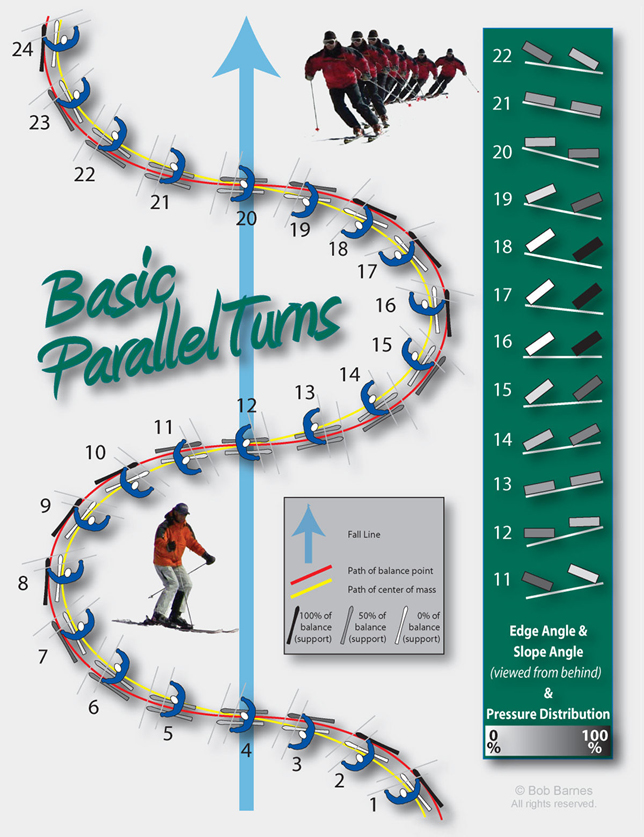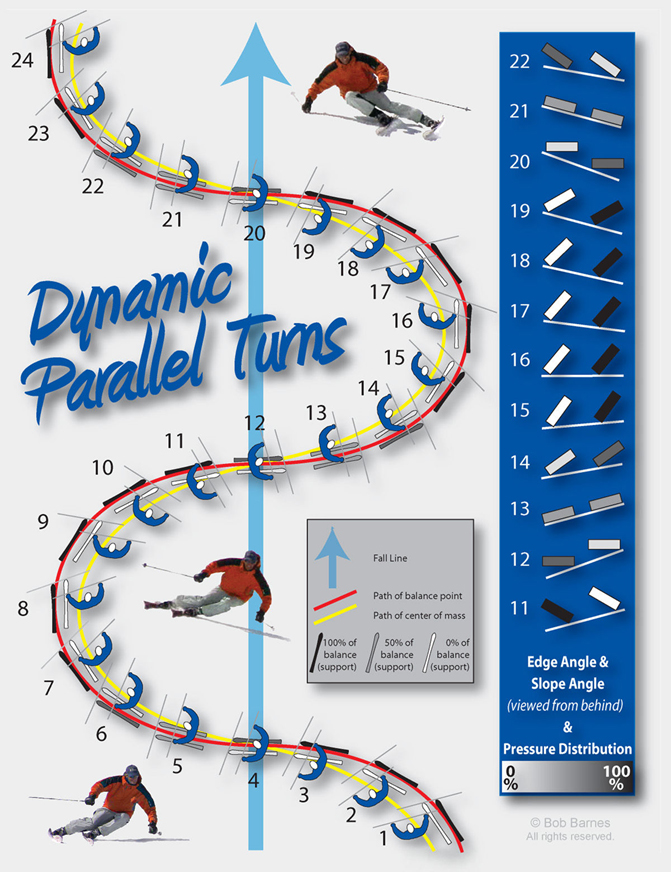Ecco quà a sostegno dei pensieri del Baldax il Bob Barnes pensiero:
Basic Turn
dinamic turn
1. The skis (and legs) rotate in the hip sockets beneath the pelvis, analogous to the steering of a car's wheels beneath the chassis. As a result, there is a subtle lead of the inside ski tip throughout the turn, passing through square or "neutral" in the transitions (frames 4, 12, and 20). The rest of the body parallels that inside tip lead--a line across the hands or shoulders would be parallel to the line across the tips. There is no rotation or counter-rotation of the upper body, and there is no blocking pole plant.
2. The skier steers the INSIDE ski tip INTO the turn, throughout the turn. While there is some skidding, especially noticeable in the lower Wedge and Basic Parallel levels, there is no PUSHING of the tails--no INTENTIONAL skidding. The skidding happens because the turns are tighter than the skis could turn purely by bending into an arc and carving, especially again at the lower levels, where neither the skills nor the forces involved are sufficient to tip and bend a ski into a tight, pure-carved arc. With greater forces and edge angles, the Dynamic Parallel turns show more carving, less skidding--because they can!
3. Both skis tip smoothly into the turn, progressively, from the start to the point of maximum edging (approximately frame 17). Then the edge angles begin to roll smoothly the other way, first reducing the angles to end the one turn, then RELEASING in the transition (frames 4, 12, and 20), and continuing to roll smoothly into the next turn. (Note that the ski does not need to be completely flat on the snow to release. It releases the moment its angle becomes less than the "critical" edge angle that we have discussed. Therefore, even the wedge turns, where the skis never become completely flat, initiate with an edge release.)
4. The skier's body (center of mass, indicated by the red dotted line) flows smoothly throughout the sequence, taking a shorter path than the skis, with the "crossover" in the transitions (frames 4, 12, and 20). The solid blue line indicates the path of the "balance point" or "center of pressure," the point on the snow where the skier's balance is focused regardless of stance width or ski length.
5. Related to #4, there is no active movement TOWARD the new outside ski (uphill) to create a weight transfer at the turn initiation. There is a weight transfer, though, as there is in a car, resulting from the forces of the turn (gravity and centrifugal force) pulling the skier progressively toward the outside ski as the turn develops. With the higher speeds (and of course, more accurate, skillful movements), the Dynamic Parallel turns show a complete weight transfer from quite early in the turn. The weight transfer is less complete in the lower speed turns, and develops more gradually. Regardless, all the turns flow through a moment of "neutral" where the pressure is equal on both skis. While I've illustrated this point in the transition frames (4, 12, and 20), in reality it often occurs later, especially at lower speeds, or on steeper slopes. Indeed, the timing and completeness of the weight transfer is hugely variable, at all levels. The weight transfers I've illustrated are typical, but not obligatory! Remember that, in these turns, weight transfer is an outcome of specific appropriate movements affected by many other variables. It is not a requirement, or an end in itself.
6. In short, these illustrations clearly show the "positive movements" that we've discussed--the signature of the "perfect turn"--as they appear at various skill levels with typical speeds, turn shapes, and condtions. They represent typical turns, not dogma! The movements, and their outcomes, will vary according to changing conditions, speeds, needs, intents, and whims of the skiers.
Have fun with these! I'd love to hear any comments or suggestions on how I could improve them.
Best regards,
Bob Barnes
Thanks for the comments, everyone. I will play with your ideas some more, although I have actually tried several of the suggestions en route to creating the illustrations that I posted. Here's my thinking on why these seemed to be the best version, so far.
Yes, the "Basic Parallel turn" illustration shows a fairly dynamic turn, not necessarily a first-day entry-level turn. But it is clearly far LESS dynamic than the "Dynamic Parallel" sequence, and somewhat more dynamic than the "Wedge Turn" sequence. Indeed, ALL the illustrations show perhaps slightly exaggerated angles.
I found it had to be this way for clarity. When I tried "actual" angles, you had to use a microscope to see the progressiveness, or even the movements at all, especially at the lower levels. Remember that the slope upon which entry level turns actually happen is VERY flat--maybe 4-5 degrees. Distributed through the frames of the drawing, that would mean a change of 1/2 degree or so from frame to frame--not even visible! So, like a relief map of the world, I had to exaggerate a little to show the movements. That is why I used the word "relative" on the drawings, but your comments show that it needs further explanation.
On the other hand, the angles shown are not far, if at all, beyond the realm of what really does happen in skiing. Those "nearly 90 degree" edge angles of the racer (Hermann Maier) actually do happen--check out some of Ron's pictures at ronlemaster.com, including the one of Maier that welcomes you to his home page. "Basic Parallel" encompasses a pretty wide range of skill levels and speeds, too, and I don't think the turns I illustrated are outside that range.
Nolo--I don't see a need for, or observe a reality of, more skidding in a wedge turn than in a basic parallel turn, necessarily. That outside ski can run the gamut from pure-carving to pure sideways braking, regardless of what the inside ski does, can it not? In fact, in the "wedge christie" (begins with a wedge, ends parallel), don't you find most instructors skidding MORE in the parallel phase, after they match? (Not that they should....) A point I've wanted to make strongly here is that none of these turns has ANY intentional skidding. While edge angles of wedge turns MAY be less than those of parallel turns, so usually are the speeds and pitch that produce the forces that those edges must resist. In either case, the skis are steered and tipped just enough to create the desired turn shape. No more, and no less!
Perhaps this last point is the jist of the "wedge vs. parallel" battle. While many instructors STILL teach wedge turns by steering only the OUTSIDE ski, pushing it into a skid, these are exactly the "dead end movements" that more enlightened instructors rightly criticize. This is where Harald Harb and I are in complete agreement.
A couple of you have suggested little legs or boots on the ski angle indicators, so I'll play with that some more. What I've found, though, is that anything additional on this diagram clutters and confuses it even more. I've tried a lot of different things to illustrate this relationship of the changing ski angle to the changing slope angle, and not been entirely satisfied with any of them. I'll keep working on it.
Like I said, these diagrams do not lend themselves to just a casual glance--there's far too much information. Unfortunately, at the small size of the posted illustrations, it is hard to see the varying shades of gray of the skis that indicates the relative amounts of pressure on them, too.
WTG--your suggestions for lines indicating the path of the head and the path of the hips, to replace the lines shown, would be easier to draw. But they would not represent the very important relationship that "path of the cm" and "path of the balance point" indicate. The center of mass, unlike the head, shoulders, or hips, is NOT part of the body. Its location varies with changing body position. What I've tried to illustrate from the "bird's eye view" is a point that is between the head and the feet, although closer (laterally) to the head, near the hips. This is roughly accurate, and actual turns and real skiers have enough variation to make much nit-picking here irrelevant.
In any case, the relationship between the balance point--the point upon which you are balanced--and the center of mass--somewhere near the hips but variable--is the critical relationship. It is what indicates the degree of "inclination" of the skier--the angle he/she leans in for balance. The line connecting these two points at any given moment is the "line of action"--the line that indicates the direction of the total forces acting on the skier. The distance between the two lines in the drawing indicates the intensity of the turn--how "dynamic" it is. Note that the lines are farthest apart in the "dynamic parallel" sequence and closest together in the "wedge turn" sequence.
If the skier is balanced on one foot, the "balance point" will be directly under that ski--see the "dynamic parallel" sequence frames 8-16. If the skier has some weight on each foot, the balance point will be somewhere between the skis, as all the diagrams clearly indicate (but you have to look closely!).
Epic--You are not the first to suggest inverting the diagrams. (Yes, this book is a revision of THE COMPLETE ENCYCLOPEDIA OF SKIING, 3rd EDITION, which is now out of print. These illustrations are refinements of similar illustrations from the previous edition.) I've tried the diagrams oriented both ways. They both have their uses. If you print them out and turn the print "upside down" the way you suggest, you will see different things! But oriented as they are, it is easier to visualize making the turns yourself. The skier is moving forward, the direction you (presumably) usually ski, and if you practice, you can "enter" the illustration and "be" the skier! At least, that's the plan....
Thanks again, everyone. I really appreciate the comments and suggestions, and will consider them all and continue to tinker. Meanwhile, keep looking and playing with ideas. If analyzing these diagrams helps create a deeper understanding of skiing, well, that's what they're there for!
Best regards,
Bob Barnes

